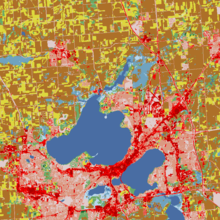Land cover

Land cover is the physical material at the surface of the earth. Land covers include grass, asphalt, trees, bare ground, water, etc. Earth cover is the expression used by ecologist Frederick Edward Clements that has its closest modern equivalent being vegetation.[1]: 52 The expression continues to be used by the Bureau of Land Management.[2]
There are two primary methods for capturing information on land cover: field survey and analysis of remotely sensed imagery.
One of the major land cover issues (as with all natural resource inventories) is that every survey defines similarly named categories in different ways. For instance, there are many definitions of "forest"—sometimes within the same organisation—that may or may not incorporate a number of different forest features (e.g., stand height, canopy cover, strip width, inclusion of grasses, and rates of growth for timber production). Areas without trees may be classified as forest cover "if the intention is to re-plant" (UK and Ireland), while areas with many trees may not be labelled as forest "if the trees are not growing fast enough" (Norway and Finland).
Distinction from "land use"
"Land cover" is distinct from "land use", despite the two terms often being used interchangeably. Land use is a description of how people utilize the land and of socio-economic activity. Urban and agricultural land uses are two of the most commonly known land use classes. At any one point or place, there may be multiple and alternate land uses, the specification of which may have a political dimension. The origins of the "land cover/land use" couplet and the implications of their confusion are discussed in Fisher et al. (2005).[3]
See also
Notes
- ^ Makers of American Botany, Harry Baker Humphrey, Ronald Press Company, Library of Congress Card Number 61-18435
- ^ "Susitna MOA Earth Cover Classification" (PDF). BlM-Alaska Technical Report 44. Bureau of Land Management. September 2002. Retrieved 15 June 2015.
- ^ Fisher, 2005.
References
- Lex Comber; et al. (2005). "What Is Land Cover?". Environment and Planning B: Planning and Design (32): 199–209.
{{cite journal}}: External link in|title= - Di Gregorio, Antonio; Jansen, Louisa J.M. (2000). "Land Cover Classification System: Classification Concepts and User Manual". Food and Agriculture Organization.
- Pete Fisher; et al. (2005). "Land use and Land cover: Contradiction or Complement". In Peter Fisher, David Unwin (ed.). Re-Presenting GIS. Chichester: Wiley. pp. 85–98.
{{cite conference}}: External link in|title=|booktitle=ignored (|book-title=suggested) (help) - Ivan Balenovic; et al. (2015). "Quality assessment of high density digital surface model over different land cover classes".PERIODICUM BIOLOGORUM. VOL. 117, No 4, pp. 459–470, 2015
